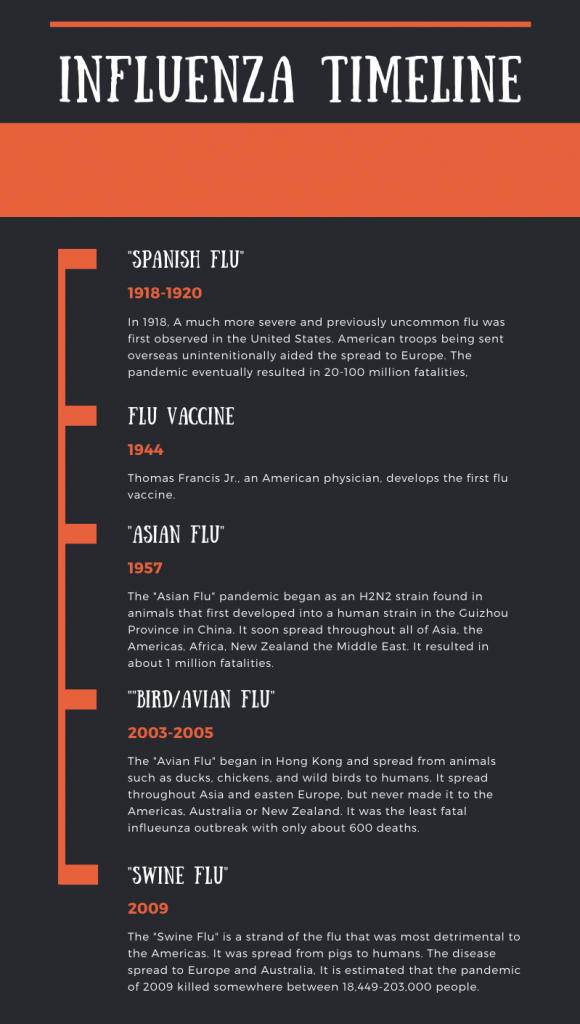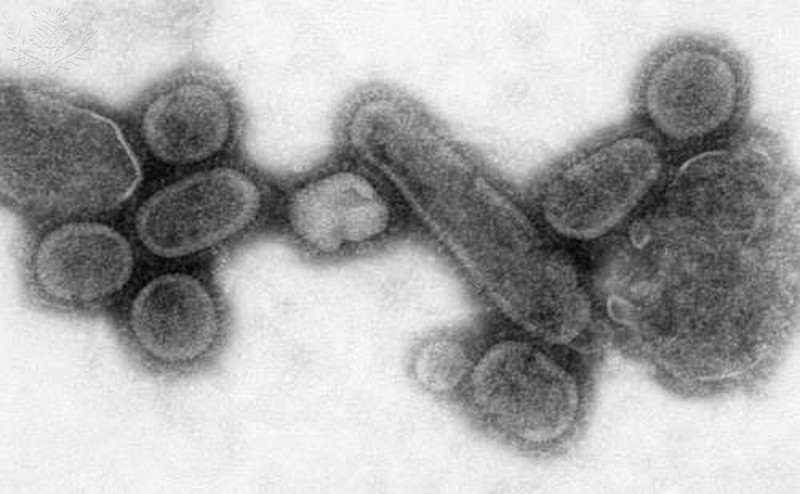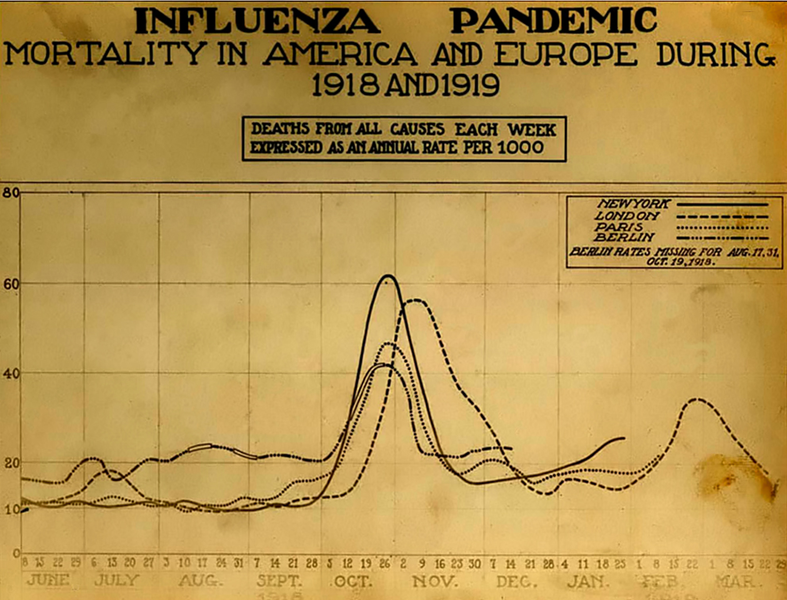By Z. Krumwiede, S. Folk, L. Daniel, A. Brandau, and K. Guma.

What is Influenza? What are the symptoms? How does it spread? What are the treatments? How can it best be avoided?

Influenza is an acute viral infection of the lower or upper respiratory tract. Influenza comes from several very closely related viruses in the Orthomyxoviridae family, which produce similar symptoms, but the antibodies the body produces are very distinct and do not resemble each other. The symptoms include general weakness, muscle pain, fever, chills, and soreness in the abdomen and head. No one is immune to the flu, but the severity of the infection depends on what other medical conditions a patient has. Furthermore, kids and young adults are more likely to get the flu, because they have not built up the antibodies to fight the virus. The influenza virus is capable of going through very rapid evolution. When a virus undergoes a major evolutionary shift it becomes a new subtype which is facilitated by animals like pigs, fish, birds, and other animals that are around people a lot. An outbreak of the Influenza virus occurs when a new strand emerges due to the evolution of the virus.
An outbreak of the Influenza virus occurs when a new strand emerges due to the evolution of the virus.
Influenza is more common during the colder months of the year, and is spread through inhalation of infected droplets through the respiratory tract (this is also the way that the COVID-19 virus is spread). The virus attacks the cells that line the trachea, bronchial tubes, and upper respiratory tract. The treatment for the type A virus is often two antiviral drugs called amantadine and rimantadine, but sometimes there is viral resistance which reduces the drugs effectiveness. Influenza can be prevented by the vaccine which often includes two or more of the ambient influenza viruses.
What is the mortality rate? Are groups of people more prone/susceptible to the flu? Where did the first cases appear?

The mortality rate for common influenza, which includes the Spanish Flu and the Swine Flu, is only 2-3%. However, up to 50 million deaths were recorded due to the Spanish Flu in 1918 and roughly 18,500 people died from the Swine Flu in 2009. The death toll of influenza this season is 18,000 to 46,000. Although everyone is equally susceptible to influenza, the virus will affect groups of people with specific medical conditions in different ways. For example, a person with a strong immune system may only contract the flu for a few days, but someone who is immunocompromised may be at a higher risk. The location of where the first cases of the Spanish Flu emerged is uncertain due to the busyness of the time period, but the first cases of the Swine Flu were identified in young Mexcians who worked closely with pigs. The swine flu virus jumped from pigs to people. That is most likely due to people being exposed to a pig-contaminated environment.
What major outbreaks have there been? When/where did these occur?

Two of the major outbreaks of influenza were the Spanish Flu in 1918-1919 and the Swine Flu in 2009-2010. The Spanish Flu came in three waves and is the second deadliest plague in history after the Black Plague. Historians are also uncertain about where the virus first emerged: the World War I battlefield, Shanxi Province in China, or Camp Funston in North America. The first wave was in March of 1918. Although it is uncertain where the first case was recorded, it can be assumed that it started somewhere on the battlefield where the conditions were unsanitary and unhealthy. The virus quickly spread through Western Europe and by July, it had reached Poland. The second wave of the Spanish Flu started in August of 1918. Instead of contracting a case of common influenza, those infected developed an ugly case of pneumonia along with uncommon influenza symptoms such as a lack of oxygen in the blood, bleeding from the nose and ears, and suffocation on their own fluids. Finally, the third wave occurred the following winter and ended it in the spring of 1919. The three waves of the Spanish Influenza left up to 50 million people dead throughout the world. Since Spain was the only location where the death toll of the Spanish Flu was released to the public, the virus was named after Spain. Naming the Virus after Spain wrongly suggests that the Spanish Flu first emerged in Spain or had some association with the Spanish population. But in reality, the origin of the virus was not at all tied to Spain.

Another of the major influenza outbreaks, is the Swine Flu outbreak in 2009-2010. The Swine Flu is a respiratory disease that has distinct antigens, which are molecules that induce an immune response, and is able to jump from pigs to humans. Those who have been exposed to contaminated pig food or bedding and show symptoms, such as a fever or trouble breathing, may have the virus. Although it rarely causes death in humans, the Swine Flu is highly contagious. Up to 22-33% of people who come in contact with the virus end up contracting it. The Swine Flu outbreak in 2009 initially emerged in young people in Mexico who had been working around pigs. The virus quickly spread through South and North America and ultimately caused 18,500 people to die.
What was the initial government response where the outbreak occurred? What was the international response to the outbreak?
The initial government response to the Spanish Flu was not panicked. The governments around the world made the choice to not make the data surrounding the virus public, which is their form of a response. The larger response came from the Allied and Axis powers, who did not want to admit to another form of death during World War I. Americans were also afraid that reporting the Spanish Flu would be violating the “Sedition Act of 1918.” The “Sedition Act of 1918” made it a crime to state, write, or publish anything containing disloyal or offensive information about the United States Government. People were afraid that reporting the Spanish Flu to the government would be suggesting their disloyalty or disagreement with World War One. Other Americans and their allied powers wanted to blame the Germans for poisoning their aspirin, but there was not any scientific or medical evidence to support them. These responses to the virus prevented countries from taking appropriate precautions and protecting their populations from contracting the deadly virus. Spain was the only country to voice its concern about the Spanish Flu and release the mortality rate data to the public. Other than Spain, not many countries voiced their opinions or concern about the virus because they were too distracted by WWI.
Spain was the only country to voice its concern about the Spanish Flu and release the mortality rate data to the public.
The first case of the Swine Flu was diagnosed in Mexico in 2009. The government of the U.S. immediately jumped to respond and immediately began analyzing lab specimens, treating diagnosed patients, frantically trying to produce a vaccine and antiviral medicines, and letting the general public know how to prevent the Swine Flu and how to get treatment. The Obama Administration was very coordinated when figuring out how to handle the Swine Flu. The U.S. government partnered with the CDC, the HHS, and the Department of Homeland Security to ensure that the outbreak was being handled well on a state and federal level. The HHS was able to store enough influenza antivirals to help 44 million people and also millions of other medical supplies to help prevent the spread of this disease and to treat patients. On the state level, all 50 states came up with a “Pandemic Flu Preparedness Plan”, purchased millions of flu antivirals, and continued to support the importance of vaccinating people over 65. This flu outbreak helped to strengthen the preparedness of the United States to be able to react much faster for an outbreak in the future.
How was the outbreak handled in the media (local, international, US)? How has media treatment of the disease changed over time?
The media’s reaction to the Spanish Flu was hushed and pushed aside by many government officials internationally. This prevented the media from spreading panic about the virus, but it also prevented people from taking the appropriate precautions. The lack of knowledge from the media could be one of the reasons why the virus spread so quickly because the public did not know how to take care of themselves. However, the single outlier, Spain, made sure that information and data about the Spanish Flu was spread across the nation not only to keep people healthy but also to explain why the death toll of the war was extremely high. One of the reasons why Spain was so concerned with the virus was because King Alfonso XIII of Spain was a victim of the flu.

Different from the reaction of the Spanish Flu, the reaction to the Swine Flu is very similar to reactions to new coronaviruses. When the Swine Flu was first discovered in Mexico and reported about in the news, the public panicked and immediately viewed the virus as deadly. In the media, the virus was very overhyped, and many places near Mexico began to generate a form of anxiety about contracting the virus. This is ironic because the death toll of the Swine Flu is very similar to the mortality rate of the common seasonal flu. However, medical professionals who created and sold the vaccine made the virus appear as more dangerous than it really was so they could produce more income. Many media sources today are admitting that the Swine Flu was not as bad as they anticipated it to be, and the virus itself is very similar to the common seasonal influenza.
What is the status of the disease now? What is the current infection rate? What advances have been made since the initial outbreak of this disease?
In 2020, influenza is only seen as a seasonal sickness. A 2018 CDC study published in Clinical Infectious Diseases discovered that about 8% of the population of the United States gets the flu every year. The infection rate ranges from 3% to 11% of the population, depending on how severe the flu season is that year. The CDC also said that the flu is so common that the number of cases can only be estimated. The flu is also very hard to diagnose based on the symptoms alone. Because of this, the advancement of a flu test has been produced to determine whether or not a person has a flu or another viral or bacterial illness. According to the World Health Organization, people that have immunosuppressive conditions like HIV/AIDS are more likely to contract Influenza. Because of this, people in places with poor medical conditions are more likely to get the flu because they are less likely to get the medical support they require to help with preexisting conditions like HIV/AIDS.
What is being done to prepare for future outbreaks?
Many people and places around the globe are currently preparing for a future outbreak of a coronavirus or an outbreak of influenza. To do this, government officials and other people of powerful positions are advising the general public to maintain healthy hygiene. It is important that people not only wash their hands to keep germs off of their bodies, but also keep hands away from the face to avoid getting germs in one’s body. For example, survivors of the Swine Flu are taking special precautions to avoid contracting the coronavirus. It is also important to stay away from people that are infected with a highly contagious virus, especially those who have specific medical conditions or may be immunocompromised.
Although governments are advising the public to take simple precautions, they are also working to establish a future plan to be able to quarantine and stop the spread of a virus very rapidly. In order to be prepared for a future outbreak, countries should have advanced medical care and treatments, especially in poverty-stricken countries where medical care is rare and viruses are likely to thrive. Another key idea is for the military to team up with medical teams. The military will provide the ability to move quickly and quarantine the virus while the medical professionals can work to heal those infected. With both the general public and government officials along with the military and medical professionals taking precautions, many countries around the world will be prepared for a future outbreak.